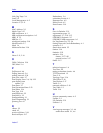
SEHI100TX MIB Structure A-3
SEHI100TX MIB Structure
Newer versions of devices with this component-based MIB architecture have
been simpliÞed somewhat; these devices support a single, global set of community
names, with small modiÞcations added automatically to accommodate multiple
instances of the same MIB component (such as network components). Again,
deÞning your device icon or launching a management application with one of
these global community names gives SPMA access to all MIB information.
Where community names may become an issue, however, is when you are using
the MIBTree or any similar MIB-based tool (such as those provided by SunNet
Manager or HP Network Node Manager) to access MIB information. For these
kinds of tools, you must supply the precise community name assigned to the
component that contains the information you want. For devices which support
the original component-based MIB architecture Ñ such as the SEHI100TX, this
means you must use the exact community name you have assigned to a speciÞc
component to access that componentÕs MIB information. (Again, note that the
SEHI100TXÕs Repeater components always have unique community names.) For
devices which support the new global community names, you must make note of
the automatic modiÞcations that are made for network components, and use
those speciÞc community names when trying to access information stored in
those components.
The MIB component descriptions provided above will serve as a roadmap for
determining where the information youÕre interested in is located; you can use the
SPMA Community Names tool (described in Chapter 3 of the SPMA Tools Guide)
to determine whether your version of Þrmware supports the original component-
based MIB architecture, or the new global community names. The Community
Names tool also allows you to both view and set the community names which
apply to your device.
NOTE
The set of community names you assign via Local Management are those which apply to
the SEHI100TX Chassis MGR MIB component.


















